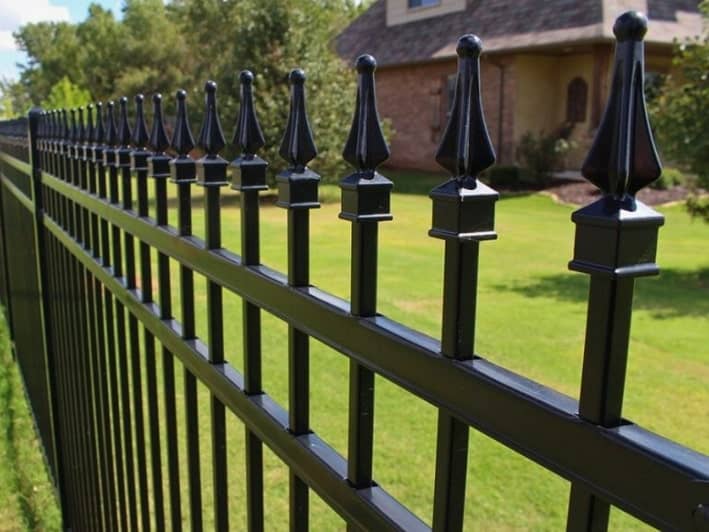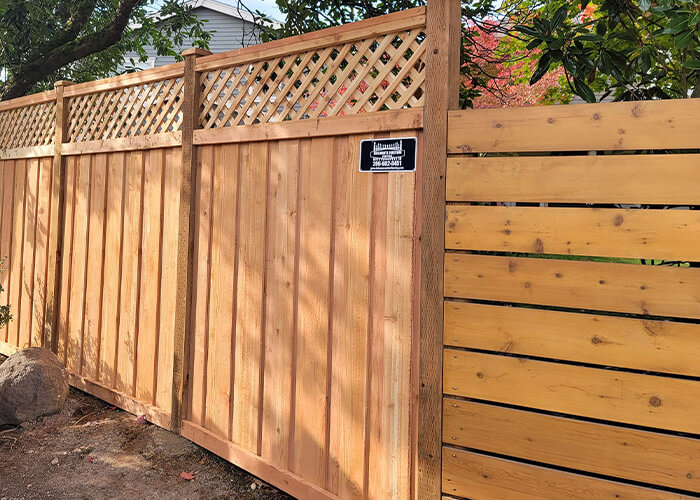Reasonably Priced Services from a Hometown Fence Contractor Owensboro KY
Exactly How to Identify Common Concerns That Call For Immediate Fence Repair
When it pertains to keeping your fencing, it is critical to spot concerns prior to they end up being bigger problems. On a regular basis looking for indicators of decaying timber, leaning panels, or corrosion can save you time and money over time. You might not understand exactly how weather condition and pests can endanger your fence's stability. Let's discover the usual indications that indicate your fencing requires prompt focus, so you can maintain your residential or commercial property safe and secure and looking its finest.
Signs of Rotting Timber in Wooden Fences
Have you seen your wood fence looking a little bit worse for wear? It might be time to inspect for indications of rotting timber if so. First, take a look at the base of the articles and panels for soft spots. If you push on the wood and it really feels mushy or collapses, that's a clear indicator of rot. Next, seek discoloration or dark spots on the wood-- these usually signal dampness damages. Focus on any kind of peeling paint or coating, as this can subject the wood to additional decay. In addition, a pungent, moldy odor can indicate fungal development. Don't fail to remember to evaluate joints and links; if they're loosened or crumbling, the timber underneath is most likely compromised. By catching these indications early, you can protect against extra extensive damage and maintain your fencing standing strong. Normal upkeep is vital to expanding the life of your wooden fencing.
Leaning or Tilting Fence Panels
If you've discovered your fence panels leaning or tilting, it's essential to understand what created it. This concern may show underlying structural damages that requires your attention. Let's explore the typical reasons and the repair options available to obtain your fence back fit.

Reasons For Leaning Panels
When you see your fencing panels turning or leaning, it's usually a sign of underlying issues that need attending to. One usual cause is inadequate drainage; extreme water can wear down the dirt around the fencing posts, deteriorating their assistance. Another culprit might be solid winds or tornados that push against the panels, especially if they're not properly secured. In addition, the natural settling of soil in time can cause blog posts to change, leading to a tilt. Parasites, like termites, can jeopardize the integrity of wooden panels, triggering them to lean. Inadequate setup methods might result in panels not being safely established, leaving them susceptible to leaning under pressure. Address these concerns quickly to keep your fencing's integrity.
Indicators of Architectural Damage
Seeing turning or leaning fencing panels can be worrying, as these issues usually indicate structural damage that requires prompt focus. When your fence begins to lean, it may signal that the blog posts are shifting or that the soil around them has actually worn down. Pay close focus to spaces between panels or blog posts, as these can also suggest instability. deck builder. Additionally, look for cracks or splintering in the wood, which can damage the overall framework. If you discover corrosion or corrosion on metal parts, it might compromise the stability of the fence. Remember, overlooking these indicators can lead to a lot more severe damages down the line, so it's necessary to analyze the situation promptly and act prior to it aggravates
Repair Options Available

Corrosion and Deterioration in Steel Fences
If you own a steel fence, you could see rust and corrosion creeping in over time, specifically if it's subjected to wetness. These problems not only impact the appearance of your fencing but can likewise jeopardize its architectural integrity. To determine corrosion, try to find reddish-brown areas or patches, which show the steel is oxidizing. Deterioration can spread out quickly if left unattended, damaging the fencing and leading to expensive repairs.To tackle corrosion and deterioration, you need to clean the impacted areas with a cord brush and apply a rust-inhibiting primer. Once the guide dries out, consider repainting the fencing with a weather-resistant paint to safeguard it further. Regular upkeep, such as examining for signs of rust and retouching paint as required, will certainly aid extend your fencing's life-span. Dealing with these problems promptly assures your steel fencing stays strong and aesthetically appealing for years ahead.
Fractures and Splits in Vinyl Fence

Reasons For Plastic Damages
Vinyl secure fencing is popular for its durability, yet it can still struggle with splits and splits as a result of numerous elements. One major reason is severe temperature level fluctuations. When vinyl increases in the heat and agreements in the cold, it can weaken the material gradually. Additionally, direct exposure to harsh sunlight can lead to UV destruction, making the vinyl brittle. Physical effects, like hefty branches or unintended accidents, can also produce splits. Poor installment or utilizing low-grade materials can aggravate these problems. Furthermore, age contributes; older vinyl fencing is a lot more vulnerable to damage. Regular assessments can aid you determine these aspects before they lead to significant issues. Take proactive steps to ensure your fencing remains solid and undamaged.
Fixing Cracks Effectively
Although fractures and divides in your plastic secure fencing can be concerning, addressing them immediately can stop additional damage and preserve the fencing's appearance. Examine the size of the crack. For small splits, a plastic fixing package commonly consists of glue that can bond the sides, supplying a smooth fix. Tidy the area completely prior to applying the adhesive, ensuring it sticks effectively. For larger splits, you might require to use a plastic spot. Cut the patch to dimension, apply adhesive around the edges, and press it strongly onto the split. Allow it to treat as per the producer's directions. Routine upkeep and quick fixings can prolong your fencing's lifespan, keeping it looking great for many years ahead.
Loose or Missing Out On Fence Articles
Missing or loosened fence articles can threaten the stability of your whole fencing structure. It's vital to attend to the issue quickly if you observe any type of articles leaning or wobbling. Look for any type of signs of movement, as this can cause additional damage over time. You can easily assess the issue by giving each blog post a gentle shake-- if it really feels unsteady, it's time to take action.For missing blog posts, you'll need to change them as quickly as possible to maintain your fencing's integrity. When you mount new messages, see to it they're firmly anchored in the ground with concrete or crushed rock for included security. If an article hangs, tighten it by including added support or driving it deeper right into the ground.Ignoring these issues can result in bigger troubles, like spaces in your fencing or perhaps total collapse. Keep an eye on your messages and remain proactive regarding repair services!
Damage From Weather Condition and Natural Environment
Weather condition and natural elements can damage your fence, resulting in various forms of damages that need punctual attention. Hefty rain can trigger wood to rot, making it weak and unstable. Snow buildup could bend or break panels, while solid winds can root out fence posts or cause sections to lean.If you observe splits or splintering in wooden fencings, it's a sign of drying due to extreme sun direct exposure. Metal fences can corrosion if protective coatings use off, specifically in coastal or moist areas.Inspect your fencing regularly after storms or severe weather to capture any type of damage early. Addressing these concerns swiftly can save you from pricey repairs down the line. Do not wait up until a little problem becomes a significant one; stay positive and keep your fence top form to maintain both performance and curb charm.
Insect Infestation and Termite Damage
It's essential to act promptly to avoid more damage when you notice signs of insect problem or termite damages. Look for mud tubes along your fence or hollow-sounding timber, as these indicate termites go to job. You may additionally see tiny holes or frass, which is termite droppings looking like sawdust. If you identify any one of these indications, it's time to examine the damage.Don' t delay until it's far too late; bugs can jeopardize your fencing's stability. Evaluate the surrounding area for beetles or ants, as they might be adding to the trouble. If you presume a problem, consider calling a parasite control expert to verify and deal with the issue.Repairing or changing afflicted sections of your fencing quickly not only recovers its strength however also prevents bugs from spreading additionally. Remain attentive to keep your residential or commercial property pest-free and safe.
Regularly Asked Questions
How Commonly Should I Inspect My Fence for Damage?
You need to check your fencing at the very least two times a year, ideally during spring and autumn. Normal checks assist you detect damages early, saving you time and money on fixings while keeping your residential property's appearance and safety.
Can I Repair a Fence Myself or Work With a Specialist?
If you have the right devices and abilities, you fence contractor can definitely fix a fence on your own. Nonetheless, employing a specialist guarantees high quality job and conserves you time, particularly for complex repair services or considerable damages.
What Equipment Are Required for Basic Fence Repairs?
For basic fence fixings, you'll need tools like a hammer, screwdriver, pliers, a saw, a level, and gauging tape. deck builder. Depending on the fixing, you could also need nails, screws, or replacement boards
Exactly How Much Does Fence Repair Service Commonly Expense?
Fencing repair service expenses vary commonly, but you can anticipate to pay in between $200 and $1,500 depending on products, labor, and degree of damage. It's wise to get several quotes for the very best deal.
When Is the Ideal Time of Year for Fencing Fixes?
The best time for fencing repairs is throughout light weather, normally in spring or early autumn. You'll avoid extreme temperature levels, making it easier to function and guaranteeing the materials established effectively for lasting resilience (deck builder). Noticing leaning or turning fence panels can be startling, as these problems frequently indicate architectural damage that requires prompt attention. Loosened or absent fence messages can undermine the stability of your entire fence framework. Snow accumulation might bend or damage panels, while solid winds can uproot fence messages or trigger sections to lean.If you see fractures or splintering in wooden fencings, it's an indicator of drying out due to extreme sunlight direct exposure. Steel fencings can rust if safety coverings wear off, specifically in damp or coastal areas.Inspect your fencing on a regular basis after tornados or severe weather to capture any type of damage early. Fencing fixing costs differ widely, yet you can anticipate to pay in between $200 and $1,500 depending on materials, labor, and extent of damages